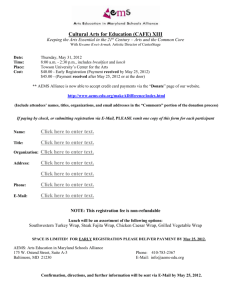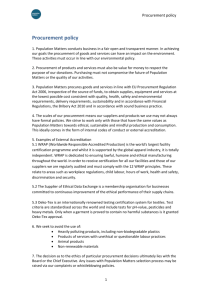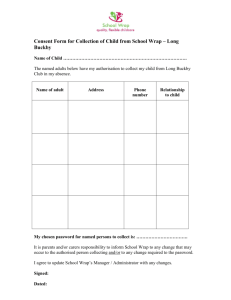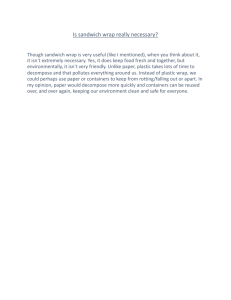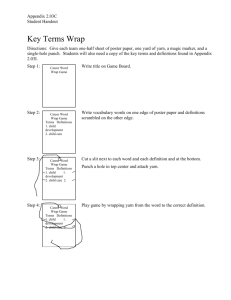The consultation questions are listed below
advertisement
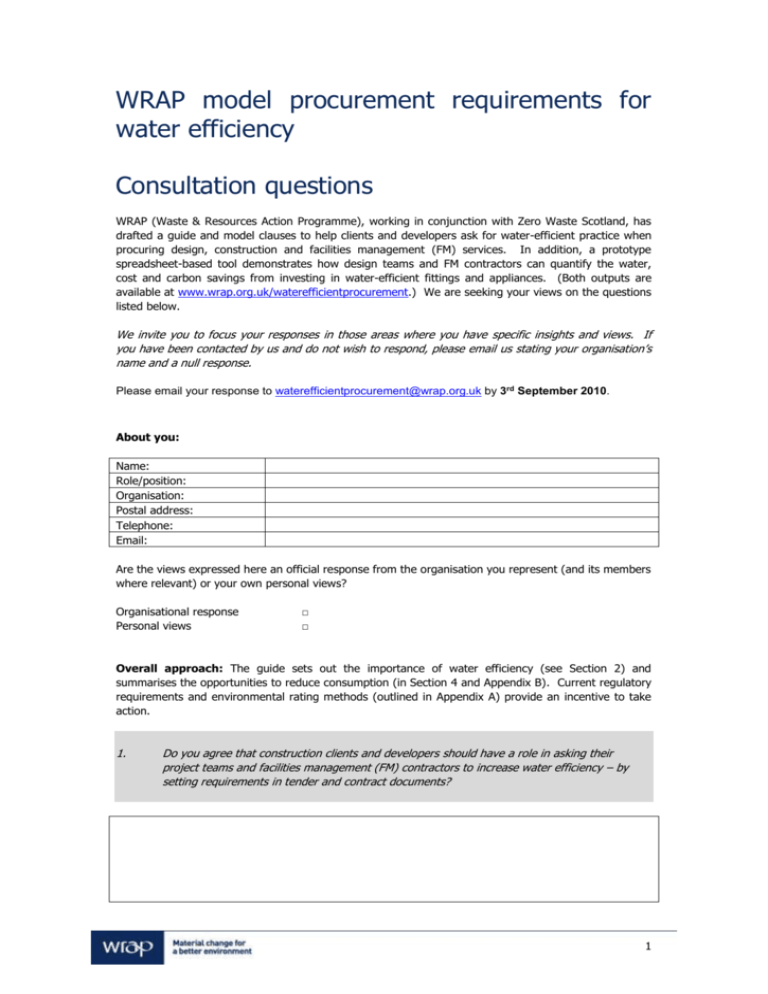
WRAP model procurement requirements for water efficiency Consultation questions WRAP (Waste & Resources Action Programme), working in conjunction with Zero Waste Scotland, has drafted a guide and model clauses to help clients and developers ask for water-efficient practice when procuring design, construction and facilities management (FM) services. In addition, a prototype spreadsheet-based tool demonstrates how design teams and FM contractors can quantify the water, cost and carbon savings from investing in water-efficient fittings and appliances. (Both outputs are available at www.wrap.org.uk/waterefficientprocurement.) We are seeking your views on the questions listed below. We invite you to focus your responses in those areas where you have specific insights and views. If you have been contacted by us and do not wish to respond, please email us stating your organisation’s name and a null response. Please email your response to waterefficientprocurement@wrap.org.uk by 3rd September 2010. About you: Name: Role/position: Organisation: Postal address: Telephone: Email: Are the views expressed here an official response from the organisation you represent (and its members where relevant) or your own personal views? Organisational response Personal views □ □ Overall approach: The guide sets out the importance of water efficiency (see Section 2) and summarises the opportunities to reduce consumption (in Section 4 and Appendix B). Current regulatory requirements and environmental rating methods (outlined in Appendix A) provide an incentive to take action. 1. Do you agree that construction clients and developers should have a role in asking their project teams and facilities management (FM) contractors to increase water efficiency – by setting requirements in tender and contract documents? 1 Formulating requirements: Responses to previous Government consultation indicate a preference for defining outcome-based targets for the water efficiency of a building, and to specify water use for fittings and appliances where more practical and appropriate. 2. Do you agree with the model wording providing options for setting requirements at a whole building performance level and/or the component level? Practice levels: a number of assessment schemes define levels of water efficiency practice for components (e.g. Water Efficient Product Labelling Scheme, Association for Environment Conscious Building water standards, Water Technology List for Enhanced Capital Allowances, Government Buying Standards) and for buildings (e.g. Code for Sustainable Homes, BREEAM, LEED, DREAM). The guide provides indicative values to assist users rather than prescribing specific standards. 3. Do you agree with the guidance provided on practice levels? (If you disagree with any individual values for practice levels, please suggest how and why these values should be revised.) Model wording: Experience in setting tender and contract requirements for waste management shows that users generally welcome model wording, which saves time and effort and can be tailored to individual projects. 4. Do you agree that the model wording in the guide is appropriate to each stage of procurement through the project life-cycle (Actions 1A to 4C)? (Please provide specific suggestions for text changes if appropriate.) 2 Water Efficiency Plan: The concept of a Water Efficiency Plan is an important element of the proposed client requirements, to encourage design teams and FM contractors to assess potential savings and define actions in a structured way at an early stage. 5(a) Do you agree that a Water Efficiency Plan can be beneficial, practical and cost-effective? 5(b) Above what project/contract value would you consider a Water Efficiency Plan to be worthwhile? □ □ □ £200k £500k £1M 5(c) Do you agree with the guidance on the content of a Water Efficiency Plan (see Section 5.2 of the guide)? (Please provide specific suggestions for text changes if appropriate.) □ □ □ £2M £5M £10M □ Other (please state) ________________ Overall guidance: The main purpose of the guide is to provide model wording for procurement, and sufficient supporting explanation – without going into detail on topics (such as design and product choice) which are addressed by other guidance and organisations. 6(a) Do you find the guidance fit for purpose? 3 6(b) What are your top three recommendations for including additional information in the guide or in other documentation? Quantifying the savings: The prototype tool estimates life-cycle cost, water and carbon savings from investments in water-efficient technologies, and helps client teams and facilities managers identify the most significant actions to take. 7. Do you agree that the tool is worth developing into a publishable format? Sector commitment: Procurement practice is a major element of the sector-wide voluntary agreement to halve construction waste to landfill by 2012, which has more than 400 signatories (see www.wrap.org.uk/construction). As another example, the Federation House Commitment aims to reduce overall water usage across the food and drink industry by 20% by 2020 (see http://www.fhc2020.co.uk). Such ‘Responsibility Deals’ or voluntary agreements have Government support. 8. Do you agree that Responsibility Deals could play a role in accelerating the move towards greater water efficiency in the built environment? What would be your top recommendations for any new Responsibility Deals (e.g. in which market segments, with what target outcomes)? 4 Other feedback: If you wish to comment on other aspects of the guide, please do so. Thank you for your comments. Please note: Representative groups are invited to identify who they have consulted in reaching their conclusions when they respond. Information provided in response to this stakeholder review may be published or disclosed in accordance with the Freedom of Information Act 2000. If you want the information that you provide to be treated as confidential, please explain the reasons and we will do all we can to exclude the information. 5


